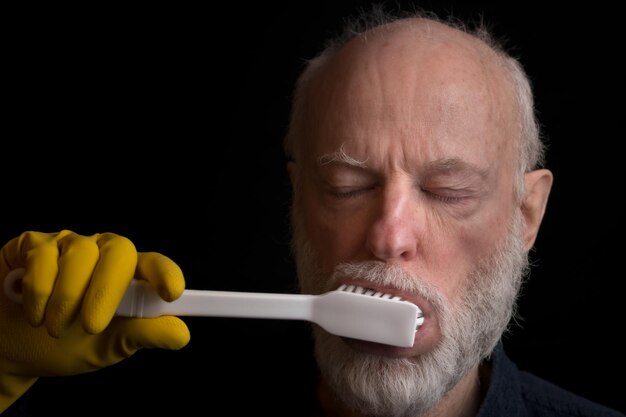Regular Dental Checkups: Preventing Gum Disease in Older Adults

Regular dental checkups are crucial for older adults to prevent gum disease, as early detection and treatment can mitigate the risk of severe complications like tooth loss and systemic health issues.
As we age, maintaining good oral health becomes even more critical. The importance of regular dental checkups for preventing gum disease in older adults cannot be overstated, as these visits play a vital role in early detection and prevention.
Understanding Gum Disease in Older Adults
Gum disease, also known as periodontal disease, is a common condition affecting many older adults. It’s an infection of the gums that can damage the soft tissue and bone that support your teeth. Let’s delve into why it’s prevalent and what makes seniors particularly vulnerable.
Factors Contributing to Gum Disease
Several factors can increase the risk of developing gum disease as we age. Understanding these factors is the first step in prevention.
- Reduced Saliva Flow: Saliva helps to wash away food particles and neutralize acids in the mouth. Older adults often experience reduced saliva flow due to medications or certain medical conditions, making them more susceptible to gum disease.
- Poor Oral Hygiene: Maintaining consistent and effective oral hygiene habits can become challenging with age. Arthritis or other mobility issues can make brushing and flossing difficult.
- Underlying Health Conditions: Conditions like diabetes and heart disease are more common in older adults and can increase the risk and severity of gum disease.
In addition to these factors, lifestyle choices like smoking or a diet high in sugar can further contribute to the development of gum disease. Recognizing these risks allows for proactive measures to protect oral health.

The Link Between Gum Disease and Overall Health
Gum disease isn’t just a problem for your mouth; it’s linked to a range of systemic health issues. The bacteria involved in gum disease can enter the bloodstream and contribute to inflammation throughout the body.
Research has shown a connection between gum disease and conditions like heart disease, stroke, diabetes, and even Alzheimer’s disease. By preventing and managing gum disease through regular dental checkups, older adults can also reduce their risk of these serious health problems.
In conclusion, understanding the factors contributing to gum disease and its connection to overall health is vital for older adults. By recognizing the risks and taking proactive steps towards prevention, seniors can maintain a healthy mouth and body.
The Role of Regular Dental Checkups
Regular dental checkups are a cornerstone of preventive oral care, especially for older adults. These appointments offer more than just a cleaning; they provide a comprehensive assessment of your oral health.
What to Expect During a Dental Checkup
During a typical dental checkup, your dentist will perform several essential tasks.
- Oral Examination: The dentist will thoroughly examine your teeth, gums, and mouth for signs of decay, gum disease, or other abnormalities.
- Professional Cleaning: A dental hygienist will remove plaque and tartar buildup from your teeth, which can’t be removed with regular brushing and flossing.
- X-Rays: X-rays may be taken to detect hidden problems, such as bone loss, cavities under fillings, or impacted teeth.
Your dentist will also discuss your oral hygiene habits and provide personalized recommendations for improving your at-home care routine. Regular checkups allow for early detection and treatment of potential problems, preventing them from escalating into more serious issues.
Early Detection and Prevention
One of the most significant benefits of regular dental checkups is the opportunity for early detection of gum disease. In its early stages, gum disease may not cause any noticeable symptoms. However, a dentist can identify subtle signs of inflammation, bleeding, or bone loss.
Early detection allows for prompt treatment, which can halt the progression of the disease and prevent irreversible damage. Regular checkups also provide an opportunity to receive preventive treatments, such as fluoride applications or antibacterial rinses, to further protect your teeth and gums.
In summary, regular dental checkups are essential for early detection, prevention, and personalized care. By attending these appointments, older adults can take proactive steps to maintain a healthy smile and prevent gum disease.
Recognizing the Signs of Gum Disease
Being able to recognize the signs of gum disease is crucial for taking timely action and seeking professional help. While early-stage gum disease may be subtle, there are several warning signs to watch out for.
Common Symptoms of Gum Disease
Here are some of the most common symptoms of gum disease:
- Red, Swollen Gums: Healthy gums should be pink and firm. If your gums are red, swollen, or tender, it could be a sign of inflammation.
- Bleeding Gums: Bleeding while brushing or flossing is never normal. It’s often an early indicator of gum disease.
- Persistent Bad Breath: Chronic bad breath, also known as halitosis, can be caused by bacteria buildup in the mouth due to gum disease.
Other symptoms may include receding gums, loose teeth, or changes in the way your teeth fit together when you bite. If you notice any of these signs, it’s essential to schedule a dental appointment as soon as possible.

When to Seek Professional Help
It’s important to remember that gum disease can progress without causing significant pain or discomfort, especially in its early stages. That’s why it’s crucial to be vigilant and seek professional help even if your symptoms seem mild.
If you experience any of the symptoms mentioned above, or if you notice any other changes in your oral health, schedule a dental appointment promptly. Early intervention can help prevent the disease from progressing and causing more severe damage.
In conclusion, recognizing the signs of gum disease and seeking professional help when needed are essential steps in maintaining good oral health. By being proactive, older adults can prevent the disease from progressing and protect their smiles.
Maintaining Good Oral Hygiene at Home
While regular dental checkups are crucial, maintaining good oral hygiene at home is equally important in preventing gum disease. Consistent and effective oral hygiene practices can help remove plaque and bacteria, reducing the risk of inflammation and infection.
Effective Brushing Techniques
Brushing your teeth properly is the foundation of good oral hygiene. Here are some tips for effective brushing:
- Use a Soft-Bristled Toothbrush: Soft bristles are gentle on your gums and won’t cause irritation or damage.
- Brush for Two Minutes: Spend at least two minutes brushing your teeth twice a day. Use a timer or music to ensure you’re brushing for the appropriate amount of time.
- Use Fluoride Toothpaste: Fluoride helps to strengthen your teeth and protect them from decay.
Angle the toothbrush at a 45-degree angle towards the gumline, and use gentle, circular motions to clean each tooth. Don’t forget to brush your tongue to remove bacteria and freshen your breath.
The Importance of Flossing
Flossing is essential for removing plaque and food particles from between your teeth, where your toothbrush can’t reach. Make flossing a part of your daily routine to maintain healthy gums.
Use about 18 inches of floss and gently guide it between your teeth, using a back-and-forth motion. Be sure to floss along the gumline, and use a clean section of floss for each tooth. If you have difficulty using traditional floss, consider using floss picks or interdental brushes.
In summary, maintaining good oral hygiene at home through effective brushing and flossing is essential for preventing gum disease. By making these practices a part of your daily routine, older adults can protect their smiles and maintain optimal oral health.
Lifestyle Factors and Gum Health
Beyond oral hygiene practices, certain lifestyle factors can significantly impact your gum health. Making healthy choices can further reduce your risk of developing gum disease and help maintain a healthy smile.
The Impact of Diet
Your diet plays a crucial role in your oral health. A diet high in sugar and processed carbohydrates can contribute to plaque buildup and increase the risk of gum disease. Conversely, a diet rich in fruits, vegetables, and whole grains can promote healthy gums.
Limit your intake of sugary drinks and snacks, and opt for healthier options like water, fruits, and vegetables. These foods can help stimulate saliva production, which helps to wash away food particles and neutralize acids in the mouth.
Choose foods that are rich in vitamins and minerals, such as vitamin C and calcium, which are essential for maintaining healthy gums and teeth. A balanced diet can contribute to overall health and well-being, including oral health.
The Effects of Smoking
Smoking is one of the most significant risk factors for gum disease. It weakens the immune system, making it harder for your body to fight off infection. Smoking also reduces blood flow to the gums, which can slow down healing and increase the risk of complications.
Quitting smoking is one of the best things you can do for your oral and overall health. If you smoke, talk to your doctor about resources and support to help you quit. Quitting smoking can significantly reduce your risk of gum disease and improve your overall well-being.
In conclusion, making healthy lifestyle choices, such as maintaining a balanced diet and quitting smoking, can have a profound impact on your gum health. By adopting these practices, older adults can further reduce their risk of gum disease and enjoy a healthy smile.
Advanced Treatments for Gum Disease
Despite diligent prevention efforts, some older adults may still develop gum disease. Fortunately, there are several advanced treatments available to manage and treat the condition. These treatments aim to remove infection, reduce inflammation, and restore damaged tissue.
Scaling and Root Planing
Scaling and root planing is a deep-cleaning procedure that removes plaque and tartar from below the gumline. It’s often the first line of treatment for gum disease.
During scaling, the dentist or hygienist will use specialized instruments to remove plaque and tartar from the tooth surfaces and root surfaces. Root planing involves smoothing the root surfaces to remove bacteria and create a clean surface for the gums to reattach to the teeth.
This procedure can help to reduce inflammation, eliminate infection, and promote healing. In some cases, local anesthesia may be used to minimize discomfort during the treatment.
Surgical Options
In more severe cases of gum disease, surgical options may be necessary to restore damaged tissue and bone. These procedures can help to reduce pocket depth, regenerate lost tissue, and improve the overall health and appearance of your gums.
Surgical options may include flap surgery, bone grafting, or guided tissue regeneration. Your dentist or periodontist will evaluate your individual needs and recommend the most appropriate treatment plan.
In summary, advanced treatments for gum disease, such as scaling and root planing and surgical options, can help to manage and treat the condition. By seeking timely treatment and following your dentist’s recommendations, older adults can restore their oral health and prevent further damage.
| Key Point | Brief Description |
|---|---|
| 🦷 Regular Checkups | Essential for early detection and prevention of gum disease. |
| 🪥 Oral Hygiene | Brush and floss daily to remove plaque and bacteria. |
| 🚭 Lifestyle Choices | Quit smoking and maintain a balanced diet for healthy gums. |
| 🩺 Advanced Treatments | Scaling, root planing, and surgery can manage severe gum disease. |
Frequently Asked Questions
▼
Older adults should typically visit the dentist every six months for regular checkups. However, those with existing gum disease or other oral health issues may need more frequent visits, as recommended by their dentist.
▼
Early signs of gum disease include red, swollen, or bleeding gums, persistent bad breath, and receding gums. If you notice any of these symptoms, it’s important to seek professional dental care promptly.
▼
Yes, gum disease has been linked to several systemic health issues, including heart disease, stroke, diabetes, and Alzheimer’s disease. Maintaining good oral health can help reduce the risk of these conditions.
▼
To prevent gum disease at home, brush your teeth twice a day with fluoride toothpaste, floss daily, and maintain a balanced diet. Avoid smoking and limit your intake of sugary drinks and snacks.
▼
Advanced treatments for gum disease include scaling and root planing, which is a deep-cleaning procedure, and surgical options such as flap surgery, bone grafting, and guided tissue regeneration to restore damaged tissue.
Conclusion
Prioritizing regular dental checkups is an investment in your overall health and well-being, especially as you age. By understanding the risks of gum disease and taking proactive steps to prevent and manage it, older adults can maintain a healthy smile and enjoy a better quality of life. Don’t underestimate the importance of regular dental checkups for preventing gum disease in older adults—schedule your appointment today!
